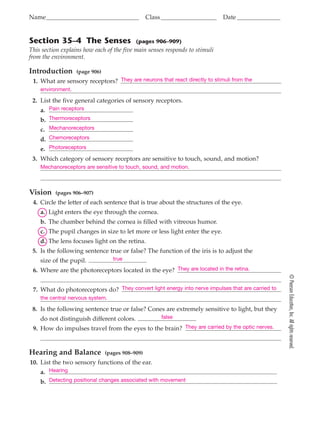Más contenido relacionado
La actualidad más candente (20)
Similar a Ch. 35 senses ws Answers (20)
Ch. 35 senses ws Answers
- 1. Section 35–4 The Senses (pages 906–909)
This section explains how each of the five main senses responds to stimuli
from the environment.
Introduction (page 906)
1. What are sensory receptors? They are neurons that react directly to stimuli from the
environment.
2. List the five general categories of sensory receptors.
a.
b.
c.
d.
e.
3. Which category of sensory receptors are sensitive to touch, sound, and motion?
Mechanoreceptors are sensitive to touch, sound, and motion.
Vision (pages 906–907)
4. Circle the letter of each sentence that is true about the structures of the eye.
a. Light enters the eye through the cornea.
b. The chamber behind the cornea is filled with vitreous humor.
c. The pupil changes in size to let more or less light enter the eye.
d. The lens focuses light on the retina.
5. Is the following sentence true or false? The function of the iris is to adjust the
size of the pupil.
6. Where are the photoreceptors located in the eye? They are located in the retina.
7. What do photoreceptors do? They convert light energy into nerve impulses that are carried to
the central nervous system.
8. Is the following sentence true or false? Cones are extremely sensitive to light, but they
do not distinguish different colors.
9. How do impulses travel from the eyes to the brain? They are carried by the optic nerves.
Hearing and Balance (pages 908–909)
10. List the two sensory functions of the ear.
a.
b. Detecting positional changes associated with movement
Hearing
false
true
Photoreceptors
Chemoreceptors
Mechanoreceptors
Thermoreceptors
Pain receptors
©PearsonEducation,Inc.Allrightsreserved.
Name______________________________ Class__________________ Date ______________
BIO_ALL IN1_StGd_tese_ch35 8/7/03 5:52 PM Page 518
- 2. ©PearsonEducation,Inc.Allrightsreserved.
Name______________________________ Class__________________ Date ______________
Auditory canal
Tympanum
Semicircular canals
Cochlea
12. Is the following sentence true or false? The tympanum sends nerve impulses
to the brain.
13. Complete the flowchart.
false
11. Label each of the following structures in the drawing of the ear: auditory canal,
tympanum, semicircular canals, and cochlea.
Vibrations enter the ear through the .auditory canal
The vibrations cause the to vibrate.tympanum
These vibrations are picked up by three tiny bones, called the ,
, and .stirrupanvil
hammer
The last bone transmits the vibrations to the ,
creating pressure waves in the .cochlea
oval window
Tiny hair cells inside the produce nerve impulses that are sent
to the brain through the nerve.cochlear
cochlea
14. What is the role of hair cells in the cochlea? In response to pressure waves in the cochlea,
the hair cells produce nerve impulses that are sent to the brain through the cochlear nerve.
BIO_ALL IN1_StGd_tese_ch35 8/7/03 5:52 PM Page 519
- 3. 15. How do the semicircular canals help maintain balance? They monitor the position of the
body, especially the head, in relation to gravity.
Smell and Taste (page 909)
16. Is the following sentence true or false? Your sense of smell is actually an ability to
detect pressure.
17. How does the body detect smell? Chemoreceptors in the lining of the nasal passageway
respond to specific chemicals and send impulses to the brain through sensory nerves.
18. Is the following sentence true or false? Much of what we commonly call the “taste” of
food and drink is actually smell.
19. The sense organs that detect taste are the .
20. List the four different categories of tastes.
a.
b.
c.
d.
Touch and Related Senses (page 909)
21. What is the largest sense organ? The skin is the largest sense organ.
22. Is the following sentence true or false? The skin contains sensory receptors that
respond to temperature, touch, and pain.
23. Circle the letter of each choice that is true about the sense of touch.
a. Unlike the other senses, the sense of touch is not found in one particular place.
b. All parts of the body are equally sensitive to touch.
c. The greatest density of touch receptors is found on the arms and legs.
d. Touch is detected by mechanoreceptors.
24. Where is the greatest density of touch receptors found on the body? The greatest density
is found on fingers, toes, and the face.
true
Sour
Sweet
Bitter
Salty
taste buds
true
false
©PearsonEducation,Inc.Allrightsreserved.
Name______________________________ Class__________________ Date ______________
BIO_ALL IN1_StGd_tese_ch35 8/7/03 5:52 PM Page 520
